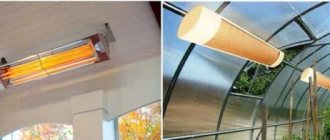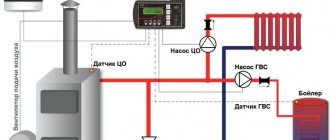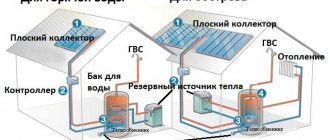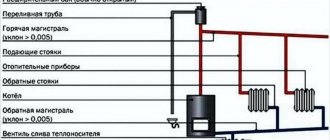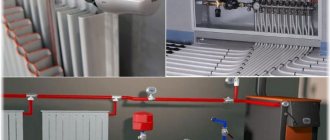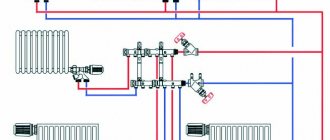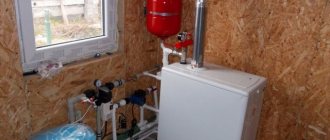The problem of saving resources gradually affects all areas of human life. If you do not save heat and energy today, tomorrow you will have to face a shortage of natural reserves. Modern science is aimed at developing energy-efficient “smart” devices, one of which is a micathermic heater with infrared radiation.
You will learn everything about the design and operating principles of this innovative type of heating devices from the article we presented. We will talk about its varieties, their characteristic differences and selection rules. We will also analyze whether thermal infrared radiation is harmful or beneficial in everyday life.
General information about micathermic heater
A micathermic heater is an electrical device that distributes infrared heat waves. IR heat is electromagnetic radiation that occupies the region of the spectrum between the red edge of light visible to the human eye (with a wavelength of λ = 0.74 μm) and microwave radiation (a wavelength of about 1-2 mm).
The heater has a multilayer design. Each of the layers of non-metals and metals included in it performs a strictly defined function. Some insulate, others concentrate and reflect heat waves. The principle of operation is extremely simple, and the design of a micathermic infrared heater is quite understandable.
Design of a micathermic heating device
The development of the MK heater is based on the achievements of space technology. However, in appearance it looks like a regular convector.
The IR device consists of:
- heating element - a mica plate, with resistive flat elements or nitrochrome wire coils immersed in it;
- an insulator that prevents excessive heating of equipment (most often done using basalt);
- metal body of the device;
- a protective metal grille through which infrared radiation passes;
- stands for supports and rollers for moving.
To control and monitor operation, the heating device is equipped with:
- remote control;
- touch or push-button control panel;
- temperature controller;
- indicator board, which helps to understand the state of the unit;
- power regulator (most models of heaters that are on sale have a power of 1-2 kW).
The main working parts of MK heaters are micanite heaters. They are produced using Micathermik technology. This technology consists of layer-by-layer application of mica onto metal heating elements.
The micanite heater is placed in a housing made of mica. It transports the thermal energy received from the heater to the room being treated. Infrared heat is directed to surrounding objects, and from them is transferred to the room being served. In this case, neither water nor oil coolants are used.
You can see the micanite heater only by disassembling the electrical equipment. But when disassembling the device, it is important not to damage the heater or change its position inside the device. If the contact density is broken, the heating effect will decrease
Micanite is paper pressed from tiny flakes of mica. This mineral, scaly in structure, is quite fragile, its layers are thinned to fractions of a millimeter. Mica has good electrical insulating, thermal conductivity and heat-resistant properties. It is often used in radioelements and capacitors.
The mineral is heated in an extremely short time, reaching 200 degrees or more. Due to the synthetic production of mica, the IR wavelength increases, while the intensity of the radiation decreases.
Mixing micanite with a heat-resistant binder and pressing them produces heat-resistant sheets with good dielectric properties that can be used in heaters. In addition, mica does not release toxic components when heated.
Mica layers insulate the heating element from the rest of the structure and transfer heat. The thickness of the mica plates is carefully selected depending on the overall dimensions of the device. Usually it is no more than 0.03-0.025 mm.
The thermal expansion of mica always coincides with the thermal expansion of the core. Thanks to this, maximum noiselessness during operation is achieved, because All kinds of clicks and knocks inside the device are eliminated.
Between the heating element and the mica plates there are 2 additional layers: inner and outer. The inner layer reflects heat, due to which infrared radiation is completely released into the space chosen for heating. The outer layer is responsible for increasing temperature flows.
The micanite heating element is placed in a metal case with mesh inserts. Infrared radiant heat passes freely through the perforated “shell.” The design is thought out in such a way that the thermal energy supplied by the device is distributed throughout the room with maximum uniformity.
The greatest infrared radiation from micathermic equipment is observed directly in front of the device, this must be taken into account when arranging objects. It is not recommended to install the device opposite the bed or in close proximity to the desktop
In addition to infrared thermal radiation, a noticeable flow of rising warm air spreads through the upper end of the grille (convection method) from the MK heater when it is put into operation, although the body of the device itself does not heat up.
During operation, the unit emits infrared and electromagnetic waves, which are in a range that is safe for living beings. Thanks to this, micathermic heaters can be used in kindergartens or hospitals.
Operating principle of MK heater
The operation of each micathermic heater is based on heat transfer by infrared radiation (80% of total performance) and convection heating by creating air movement due to temperature differences (20%). By combining 2 heating techniques, the highest possible efficiency is achieved.
Those. it heats air volume and objects through infrared radiation from a distance. Thanks to this, heat transfer occurs much faster when compared with a water or oil radiator. After all, an ordinary water, gas or electric convector heats only the air that comes into contact with its ribs.
The MK heater transfers energy to the object with minimal dissipation. The role of an object can be objects, animals, or people. Moreover, after exposure to infrared waves, things and walls themselves become sources of heat and heat the air.
Outside the range of the IR heater, the room practically does not heat up. In this case, the heat flux density decreases with increasing distance between the heater and the object.
However, an IR heater is indispensable if you need to quickly heat up one item in the room. The body of the device itself, insulated with a composition using basalt, does not reach high temperatures (above 60 degrees), which eliminates the possibility of burns due to accidental contact with the unit.
It is best to buy micathermic heaters with a steel casing. Such structures are not afraid of external mechanical influences from impacts and falls. Plus they heat up very quickly
But you cannot dry clothes on a heater, as there is a risk of fire. Some synthetic materials that come into contact with the device may melt or catch fire. The exception is special, improved models equipped with shelves for shoes or folding dryers for clean clothes.
Technically, the operating principle of the elements of a micathermic heater is quite simple. When the device is turned on, the plate begins to heat up. It heats up to 200-400 degrees Celsius and transfers heat to the mica layers.
The electrical energy imparted to the mica plates is transformed into infrared radiation directed at objects near the electrical appliance. This entire process takes a few minutes, and the room becomes warm almost immediately after turning on the equipment.
A small room (up to 20 sq.m.) can be heated with a micathermic device in 10 minutes. When the air in the room reaches the desired temperature, the thermostat in the unit is activated, turning off the heater. The equipment can be configured to automatically maintain a comfortable temperature background in the room.
High energy efficiency and cost-effectiveness are the main features of micathermic heaters. They are characterized by high power, so they consume less electricity by about a third compared to conventional convectors. The efficiency of an infrared heater is about 90%.
Useful additional options
Standard MK heaters have a minimum number of settings, but some of them have various additional elements depending on the modification.
These elements include:
- built-in thermostats that allow you to control multiple air flows;
- liquid crystal displays with special protective functions;
- air ionizers and humidifiers;
- timers, etc.
Many micathermic heaters have the function of protecting the room from freezing. If you activate this option and install the device in an unheated room, it will automatically turn on if the temperature in the room approaches zero.
Also, some heaters are equipped with an IP24 degree of protection, which protects against moisture and prevents the possibility of damage to the device or short circuit if water gets on the equipment.
All additional devices are initially built into the design of the micathermic heater. The exact configuration depends on the technical characteristics of the heater: its power, mounting method and dimensions
How to choose a micathermic heater
Now let's look at what you should pay attention to when choosing.
- The first thing to consider is the area of the heated room
. With a standard ceiling height and good insulation, models with a power of up to 1500 W are suitable for rooms up to 25 m2; for larger rooms (up to 30 m2) or with high ceilings, you should choose more powerful models of 2000 W. - If you want to control the temperature
, then you need models with a mechanical or electronic thermostat. The thermostat will maintain the desired temperature and save energy consumption by automatically turning the heater on and off. - For maximum comfort,
choose options with a remote control. In this case, the maximum number of settings is available to you.
Below are the models available for order. For more detailed information, click on the “More details” link for the product you are interested in.
The most popular micathermic heaters
| Model | Power | Heated area | Additional options |
| Polaris PMH 1514 Read more… | 1000/ 1500 W | 24 sq. m. | Adjustable thermostat, overheat protection, Anti-frost system, rollover shutdown |
| Polaris PMH 2015 Read more… | 1500/ 2000 W | 30 sq. m. | Adjustable thermostat, overheat protection, Anti-frost system, rollover shutdown |
| Polaris PMH 1516RCD Read more… | 1000/ 1500 W | 24 sq. m. | Remote control, electronic thermostat, LED display, overheat protection, Anti-frost system, rollover shutdown, timer |
| Polaris PMH 2017RCD Read more… | 1500/ 2000 W | 30 sq. m. | Remote control, electronic thermostat, LED display, overheat protection, Anti-frost system, rollover shutdown, timer |
| VES MX1 Read more… | 1500 W | 24 sq. m. | IP 24, overheat protection, Anti-frost system Can be used in bathrooms! |
| VES MX5 Read more… | 1300 W | 20 sq. m. | Overheat protection, rollover shutdown |
| VES MX6 Read more… | 2000 W | 30 sq. m. | Adjustable thermostat, timer, overheat protection, tip-over shut-off |
| VES MX11 Read more… | 1300 W | 20 sq. m. | Adjustable thermostat, operating mode indicator, Anti-frost system, rollover shutdown |
You can choose a micathermic heater here!
If you need advice on choosing the right heating device for a specific room, call us at tel. (as well as free calls and messages via Viber, What's Up).
Classification by direction of radiation
All micathermic heaters are divided into:
- one-way devices, in which infrared rays are directed only in one direction;
- double-sided devices that radiate heat in both directions on the sides of the product;
- cylindrical units having a circular zone of infrared radiation.
Single-sided heaters can be wall-mounted or floor-mounted. They have a mesh front and back. The back side has small ventilation holes at the bottom.
Double-sided heaters are installed on the floor. They have two working plates that produce infrared rays. The heating plates are equipped with metal mesh. Single-sided and double-sided heaters direct infrared rays horizontally along the floor.
The horizontal supply of IR rays contributes to uneven distribution of heat in the room. With infrared radiation, the warmest air is closest to the floor, which helps keep your feet warm. Higher towards the ceiling it is usually colder.
Heaters should be installed in the coldest parts of the room. However, they are not recommended for use in rooms with high humidity (bathrooms, laundry rooms, showers). In such places, electrical appliances are installed with protection from the effects of moisture suspended in the air.
Heaters of cylindrical or oval shape contain radiators of non-standard configuration (semi-ring or tubular). They can be attached to the ceiling or walls, depending on the features of the structure. Cylindrical heaters are distinguished by a circular zone of infrared radiation.
Types of micathermic heaters
This type of heating equipment is divided according to the shape of the housing and the method of installation. If the shape and design of micathermic heaters is just a matter of taste and personal preferences, then the installation method very seriously affects the efficiency of the device:
- The standard option is a one-sided micathermic heater installed on the wall, under a window opening or directly next to the front door of the house;
- Ceiling micathermic heater. Installing an electric heater on the ceiling may seem unusual and not always justified, but for this type of device the ceiling location is considered one of the most effective;
- Portable models, most often on wheeled supports, allowing you to easily move the heater within an apartment or house.
According to the design of the body, heating devices are traditionally manufactured in double-sided, single-sided and cylindrical shapes. Since a micathermic heater is a functional device and not an interior element, there are no innovations or unexpected design solutions here.
Common Use Cases
Infrared heaters can be used in indoor and outdoor areas. With their help you can heat a terrace, balcony, nursery or living room. Also, MK devices with the ability to heat by convection are appropriate to prevent the appearance of ice on the staircase.
Because when heating a room with infrared rays, there is no less oxygen in the air (and it does not dry out), IR devices are recommended for use in rooms where small children, asthmatics or allergy sufferers live.
But micathermic systems serve not only private owners; they are in demand in:
- medicine for the treatment of patients with blood flow disorders, cardiovascular pathologies, migraines and frequent acute respiratory infections;
- veterinary medicine for the treatment of animals;
- massage rooms (massage under infrared radiation helps reduce weight);
- offices to destroy viruses and bacteria.
Using micathermic heaters, you can create thermal curtains over panoramic windows and other translucent glass structures that have poor thermal insulation properties.
To kill bacteria, the micathermic heater should be left on for several hours. However, it is not recommended to use this device solely for disinfection, because... the device does not kill all viruses, fungi and mold that are in the room
Operating principle of a micathermic heater
During operation, the micathermic device emits infrared rays that strike surrounding objects and heat them. Radiation can penetrate 20-30 mm inside. The depth of heating depends on the structural characteristics of surrounding objects.
Micathermic infrared devices are more efficient than convectors and oil radiators. The room is heated simultaneously using two methods:
- convection;
- through infrared radiation.
IR devices are absolutely safe, so they can be installed even in a nursery
Advantages and disadvantages of micathermic heaters
The advantages and disadvantages of a micathermic heater are determined by the operating principle and design of the equipment.
The device has an impressive number of advantages, which include:
- energy efficiency;
- high heating speed;
- compact body;
- stylish appearance;
- light weight (depending on the type of unit varies in the range of 3-4 kg);
- safety;
- maintaining a healthy indoor microclimate;
- minimal background noise during operation, etc.
Also, a micathermic heater prevents the development of microbial and viral microflora, and also kills fungus in the room. However, this device does not have a bactericidal effect and cannot be used along with ultraviolet lamps for quartz treatment.
During operation of the infrared device, no accumulation of air mass is formed under the ceiling. Thanks to this, IR equipment is perfect for rooms with high ceilings, because... heat will not dissipate over the entire area. But through the holes in the casing of the unit a lot of dust gets in, which is almost impossible to get out of there.
When you turn on the device, dust and dirt become hot and smell bad. The smell will disappear only when the dust burns completely. It is noteworthy that a micathermic heating device will emit such a stench whenever it is left turned off for a long time.
Pros and cons of micathermic heaters
I would immediately like to understand the advantages and disadvantages of this type of heating equipment in order to understand whether such a device should be considered as a heat source for a home, office or other premises.
Advantages of the new product:
- Comfortable indoor microclimate.
Everyone knows how a regular oil radiator dries out the air and smells of burnt air. In contrast, the Micathermic heater is an infrared heating device, and with infrared heating the air is not dried out and the oxygen content is not reduced. Therefore, this type of heating is especially recommended for children, asthmatics, frequently ill people and, in general, for those who care about comfortable breathing in a heated room. - Economical.
The new product consumes 30% less electricity than traditional oil or electric radiators. The efficiency factor (i.e., efficiency) of micathermic analogues is more than 85%-90%, which allows you to heat a larger room with less energy consumption. - Fast heating.
On average, the device reaches operating temperature in 1 minute, almost immediately starting to emit heat. - Safety.
The outer casing does not heat up to temperatures above 60⁰, which makes the device safe for children and pets. There is often built-in overheating and tip-over protection. - Ease of use.
Many models have 2 heating modes, a thermostat for adjusting the temperature, additional functions such as a timer or “Anti-Frost” (protecting the room from freezing). Some models are equipped with a remote control. - Mobility.
Light weight and wheels make it easy to move inside and between rooms. - Silence.
The absence of noise allows the device to be used in bedrooms, children's rooms and offices. - Affordability.
Despite such significant advantages, some disadvantages
:
- The heater primarily releases heat to the surrounding space. The further you are from the device, the cooler the air will be. However, convection helps distribute heat throughout the room more evenly.
- The price of models with additional functions or with remote control will be higher than similar standard devices.
- It is possible that when you turn on the device for the first time after a long period of inactivity, you will notice the smell of burning dust particles that have settled while the product was not working. However, during further operation there will be no odors in the air.
- The body temperature of 60˚ makes it impossible to burn a person. But you need to avoid getting synthetic things on the device (for example, tulle, flammable objects made of plastic or film). Do not use the electric heater to dry clothes, towels, linen, shoes, etc.
We are confident that if you follow the manufacturers' recommendations for installation and proper operation, Mica-thermic will delight you for a long time with warmth, comfortable indoor air and reduced heating costs.
How to choose the right model?
When purchasing a micathermic heater, you need to take into account the characteristics of the room in which it will be placed. Approximately for every 10 sq.m. housing you need to take 1 kW of power without taking into account heat loss.
If this will be the only heat source, you need to choose a device with more power. If you buy an infrared heater for a small summer house, you can choose a device with a power of no more than 70 W per 1 sq.m.
In reality, it is difficult to heat a room with only one micathermic heater, because... you need to think very carefully about the location of the device. Maximum heating of air and objects will be observed only at a distance of a couple of meters from the front panel.
Before purchasing an MK heater, you need to ask the seller for all the necessary accompanying documentation, incl. hygienic certificate for the isolator. It is better to buy equipment with a basalt insulator, which can be used even in the food industry (marks about this are usually present in the hygiene certificate).
Any electrical equipment needs timely and complete care. Due to their structure, micathermic heaters must be regularly vacuumed and wiped with a damp cloth to remove accumulated dust. Before cleaning the device, turn off the power.
Rating of micathermic heaters
Specialized retail chains offer a wide selection of different models of micathermic heating units. Almost every device is endowed with significant advantages, which creates difficulties in the process of selecting an infrared device. Below you can see the rating of the most popular and reliable micathermic heaters, which are preferred by property owners.
Polaris PMH 1571D
A fairly functional heater model, characterized by high quality and reasonable cost. The power of the device, which can be adjusted if necessary, is within 1.5 kW. The presence of an electronic method for controlling the structure is a definite advantage. The manufacturer took care of installing a timer and the possibility of fixing the device on the wall. The weight of the device reaches 5 kg. Thanks to the presence of wheels and a handle, moving the heater to another area is not difficult.
Polaris is a popular model that pleases with reasonable price and high quality
VES MX 10
The heater is compact in size and easy to operate. The ability to adjust power within 800, 1200, 2000 W is a significant advantage. The device control system is mechanical. The presence of wheels and a handle makes it easier to transport the heating device around the house. The minimalist design and high quality of the product have become the reason for the widespread popularity of this model.
When the VES MX 10 is turned on, the indicator turns red
Bimatek PH310
The compact heating device is designed to heat a room whose area does not exceed 15 square meters. m. The presence of a mechanical switch allows you to adjust the power level and temperature conditions. The manufacturer also took care of installing a timer, which makes it possible to set the time to turn the device on and off. The wheels and handle located on the structure are designed to facilitate the process of moving the heating device around the house. The anti-tip function effectively prevents the device from falling.
The Bimatek PH310 micathermic heater model has compact dimensions
Polaris PMH 2095
A popular model of a micathermic heating device, the power of which can be adjusted to save money. Equipped with a switch with a light indicator. There is no wall mounting type. When overheated, the device automatically turns off. Lack of noise during operation and safety are the main advantages of the Polaris PMH 2095 model. The device can quickly heat a room whose area reaches 15-18 square meters. m.
During operation of the Polaris PMH 2095, the body part does not heat above 60 °C
Slogger SL-1010
The infrared micathermic heater has high power, which allows you to heat a room of 20-25 square meters. m. The electronic type of control of the device improves ease of use. The presence of a control panel makes it possible to control work from a distance. The heater can be installed on the floor or mounted to the wall.
Important! The main advantage of the model is the presence of ionization and air humidification functions.
The micathermic model Slogger SL-1010 not only does not dry out the air during operation, but also helps improve the microclimate
Is infrared waves harmful to the body a myth?
Infrared waves are traditional electromagnetic radiation, similar in structure to solar rays. The harm and benefits of infrared radiation are determined by the depth of penetration of these waves into the skin.
There are 3 types of heating devices depending on the wavelength and incandescent temperature of the heating element:
- devices with maximum heating up to 300 degrees and wavelength 50-200 microns;
- devices heating up to 600 degrees and with a wavelength of 2.5-50 microns;
- heaters with heating up to 800 degrees and a wavelength of 0.7-2.5 microns.
Those. The higher the filament temperature of the device, the more short waves will be emitted. For an ordinary healthy person, heat waves with a length of about 9.6 microns are safe. Manufacturers indicate the range of infrared radiation in the technical device data sheet.
Information about the range of infrared radiation can be found in the accompanying documentation for the heaters or on the product box. The absence of this information indicates significant violations on the part of the manufacturer
Typically it varies between 2-10 microns. In this case, the intensity of IR radiation depends on the characteristics of the heated surface (especially its emissivity). The most powerful radiation comes from a heated black object.
Any prolonged targeted infrared radiation has a bad effect on the human body, which is expressed in:
- drying out of the skin;
- decreased vision (long-term exposure increases the risk of developing cataracts);
- disruption of the structure of cell membranes (typical of short infrared waves), etc.
It is especially dangerous to install a powerful ceiling heater in a room with low ceilings. In this case, infrared rays will constantly heat a person’s head and can lead to the development of all kinds of diseases.
But these infrared heaters can only cause real harm if the flow is constantly directed at a person. Ideally, the devices should be installed so that the heaters give off their heat to walls or pieces of furniture, but are not directed at a person.
The heater should not be directed at the person all the time. Infrared radiation is only useful in small quantities
However, in Japan and Europe, entire institutes are developing methods to combat cancer based on the influence of infrared radiation. Scientific research has proven that infrared waves, reaching 14-20 cm inside the skin, effectively detoxify cells.
This occurs due to selective hyperthermia, increasing biochemical circulation and eliminating congestion in tissues. The result of using radiation depends on correctly selected circuits, and a micathermic heater is absolutely safe for health if you use common sense when installing it.
Operating principle
A micathermic heater is a household electric heating device, the infrared radiation of which is transmitted to heat objects, at the same time heating the air and adding a convection effect. Despite the combined effect, the device belongs to the group of infrared emitters, along with halogen heaters. The principle of operation of an infrared heater is that long-wave thermal radiation, or infrared rays, heats not the air, but the surface of surrounding objects. This warmth is perceived by a person as pleasant.
The operating principle of a micathermic heater is to combine the infrared effect with the convection effect. Convection is the heating of air in contact with a warm panel and its circulation in the room. The combination of different heat exchange processes (80% infrared radiation and 20% convection transfer) contributes to the productivity of a working heating device: 1 surface gives off about 9 watts of heat.
Conclusions and useful video on the topic
The video provides an overview of the MK-1501 micathermic heater - innovative equipment, using an example of which you can understand the principle of operation of infrared heaters:
A micathermic heater is an innovative electrical device that is used for heating rooms. Its functioning is based on infrared radiation from micanite elements. The equipment is characterized by high inefficiency, energy efficiency, compactness and versatility.
Would you like to share your own experience in choosing an infrared heater? Do you have useful information on the topic of the article? Please write comments in the block below, post photos, and ask questions.
What is a micathermic heater
Micathermic heater means an innovative device that works on the principle of infrared radiation. Conventional radiators use a coolant - water or oily liquids, designed for especially low temperatures.
In contrast, a micathermic device is equipped with solid heating elements. It does not leak, is easier to operate and maintain, and has a high degree of safety.
When using a micathermic heater, the effect is noticeable immediately, and not after 2-3 hours
How does a micathermic heater work?
Structurally, a micathermic heater consists of several parts:
- metal body with grilles on both sides;
- metal plate;
- multilayer mica coating.
When the device is turned on, the metal plate heats up quickly. The heat transfers into the mica coating and is evenly distributed in two directions from the unit through the grates. The operating principle of a micathermic heater is that the radiation it emits is infrared. Approximately 80% of the heat generated quickly penetrates into objects located near the unit, and only 20% is dissipated in the air around the device.
